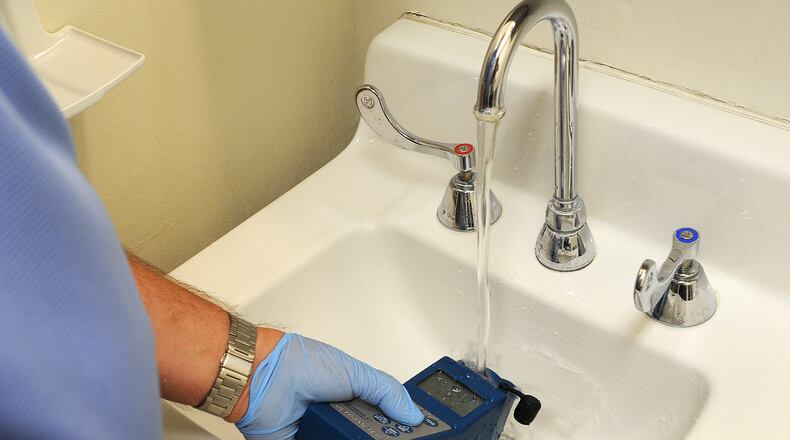What is Legionella bacteria and Legionnaires’ disease?
Legionella is a bacteria found in fresh water such as lakes and streams. But, according to the CDC, it becomes a health risk when it grows in buildings and water systems such as shower heads and faucets, hot tubs that aren’t drained after each use, decorative fountains and water features, air conditioning units, hot water tanks, and heater and large plumbing systems that aren’t used for an extended period of time.
When the stagnant water is turned on or is stirred for the first time, the bacteria forms droplets that can cause pneumonia ― Legionnaires’ disease ― when people breathe it in, said Dr. Steven Burdette, medical director of infection control at Miami Valley Hospital.
Legionnaires’ disease is a serious type of pneumonia, or lung infection, according to the Centers for Disease Control. People can develop the illness if they breathe in small droplets of water or accidentally swallow water containing Legionella into the lungs.
Legionella commonly occurs in “multiple locations and multiple water systems,” Dan Suffoletto, public information supervisor the health department, has said.
But it can’t be determined where a person contracted Legionnaires’ disease and it affects people with a weakened immune system more, he added.
Who has been affected?
Kettering schools Spokeswoman Kari Basson said, “We do know a number of student-athletes have been ill in the past few weeks...This is what we are able to share at this time.”
In 2019, a Kettering Fairmont High School custodian died of Legionnaires’ disease. Given the most recent discovery, the district is working to see if all other buildings — which are set to be tested in July — can be evaluated sooner.
What are the symptoms?
Legionnaires’ disease is similar to other types of pneumonia. Symptoms include coughing, shortness of breath, fever, muscle aches, and headaches, according to the CDC. Additional symptoms can include diarrhea, nausea, and confusion. Symptoms typically start two to 14 days after being exposed to the bacteria, but it can take longer, the CDC says.
“Public Health does not test for or regulate specific legionella levels. Effects of personal exposure to legionella bacteria is dependent on a variety of factors including; duration of exposure, level of bacteria, type of bacteria and personal health factors,” Suffoletto said.
What is the treatment?
Legionnaires’ disease often requires antibiotics and hospital care. The CDC says most cases can be treated successfully, and healthy people usually get better. But about 10 percent die due to complications.
How common is it?
“The last reported case of Legionnaires’ disease in Montgomery County was June 13. There have been 12 total cases reported this year, none in youth,” said Suffoletto.
Suffoletto said the 2023 numbers are preliminary, adding that in 2022, there were 33 reported cases locally, and in 2021, there were 60.
What can be done about it once it’s found?
“When legionella bacteria is found in water sources, there are ways facility managers can work with private contractors to reduce bacteria levels,” Suffoletto said. “Which specific actions can be taken depends on where the bacteria is found and how the water system is designed.”
What type of remediation is being done at Fairmont High School’s field house?
Solid Blend Technologies Inc. is set to start remediation at the field house on Friday, It will include:
• Sanitizing and installing a new filter on the ice machine
• Cleaning and sanitizing drinking fountains
• Flushing all pipes using hyper-chlorination
• Retesting all water sources after 72 hours
Past cases in area schools
In 2019, a Kettering Fairmont High School custodian died of Legionnaires’ disease. Given the most recent discovery, the district is working to see if all other buildings — which are set to be tested in July — can be evaluated sooner.
In 2020 four positive tests for Legionella bacteria at Fairmont High School came from the custodian office bathroom sink, just west of the cafeteria. A custodian also tested positive for Legionnaires Disease at that time.
Tests also revealed Legionella bacteria in the water supplies of school buildings in Dayton, Northmont and Vandalia-Butler school districts.
In 2022 Legionella was found in Oakwood schools, it was the third straight year tests discovered the bacteria in the district.
Can Legionella get in your home?
Legionella can be found in homes. However, it is less likely because of the reduced chance for stagnant water. Houses are small enough that water moves through them quickly, and Legionella doesn’t have time to take root.
Legionella can survive between 68 degrees and 122 degrees, but it thrives between about 95 degrees and 108 degrees. It is recommended to keep the home’s hot water tank as hot as possible ― preferably above 120 degrees ― without scalding yourself.
Experts also recommend removing the aerators from all faucets, clean them and disinfect them in a cup of household bleach for 10-15 minutes every 90 to 120 days.




